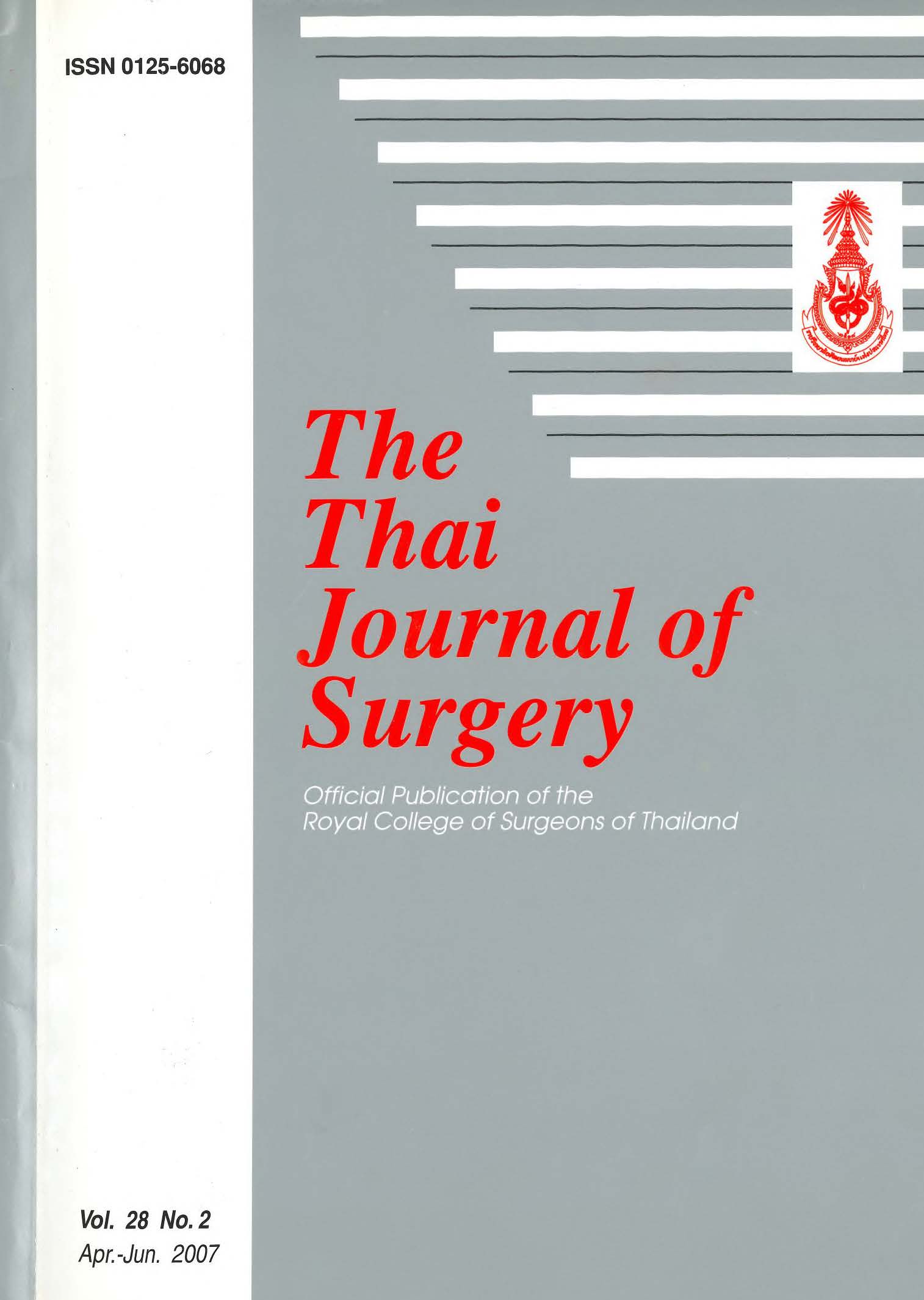Efficacy of Medical Management of BPH with Lower Urinary Tract Symptoms: Urodynamic Studies at Chiangmai University Hospital
Keywords:
benign prostatic hyperplasia, medical treatment, urodynamicsAbstract
Background: Nowadays medical treatment of BPH with lower urinary tract symptoms (LUTS) with α1 -adrenoceptor antagonists/α1-blockers and 5α-reductase inhibitor (Finasteride) is often practiced among urologists and general practitioners. Many patients receiving these medications get some improvement of symptoms but the efficacy of reducing bladder outlet obstruction (BOO) is questionable. The purpose of this study was to study the efficacy of the drugs in relieving BOO by urodynamic studies.
Materials and Methods: Urodynamic data of 26 patients with age ranged from 47-88 years (mean 69.52± 8.24 years) who had slight or no improvement of LUTS during medical management (duration 2-96 months, mean 29.52 ± 30.39 months) were collected for analysis. Blaivas's criteria of male voiding dysfunction were used. These patients were divided into 2 groups. Obstructed group consisted of 13 patients (50%), of which 2 patients had previous TURP (inadequate). Of 13 patients, 9 received α1-blockers, 3 received combination of medications (both α1-blockers and 5α-reductase inhibitor), 1 received only 5α- reductase. Two of these patients underwent urodynamic studies during on- and off-medication period and were compared. Unobstructed group consisted of 13 patients (50%), 4 had previous TURP. Of these, 11 received α1-blockers, 2 received combination of medications.
Results: The results of the urodynamic study in 26 patients receiving medications were analyzed. In obstructed group, average Pdet. Qmax was 78.69± 31.44 cm. H2O and Qmax was 6.46 ± 5.15 ml/s. Of these 13 patients, 2 stopped medication more than one year and Pdet. Qmax was 76 ± 22.62 cm.H2O, Qmax 6.5 ± 3.5 ml/s; while on medication Pdet. Qmax was 80 ± 35.35 (p= 0.907) and Qmax was 6 ± 2.8 (p=0.891). In unobstructed group, average Pdet. Qmax was 24.53 ± 9.49 cm.H2O, Qmax 10.38 ± 6.97 ml/s.
Conclusions: The medical management of BPH with lower urinary tract symptoms can improve lower urinary tract symptoms but cannot relieve bladder outlet obstruction. Prescribing these medications is unnecessary for unobstructed patients. Before prescribing, the property and efficacy of each drug should be explained and discussed with the patients.
References
2. Chon JK, Borkowski AW, Partin AW, et al. α1-adrenoceptor antagonists Terazosin and Doxazosin induce prostate apoptosis without affecting cell proliferation in patients with benign prostatic hyperplasia. J Urol 1999; 161: 2002-8.
3. Caine M. Alpha-adrenergic blockers for the treatment of benign prostatic hyperplasia. Urol Clin North Am 1990; 17:641-9.
4. Abrams P, Speakman M, Stott M, et al. A dose-ranging study of the efficacy and safety of tamsulosin, the first prostate-selective α1A-adrenoceptor antagonist, in patients with benign prostatic obstruction (symptomatic benign prostatic hyperplasia). BJU 1997; 80: 587-96.
5. Finasteride (MK-906) in the treatment of benign prostatic hyperplasia. The Finasteride study group. Prostate 1993; 22:291-9.
6. Frankel S. Analyzing finasteride data. Neurourol Urodyn 1995;14:619-24.
7. Blaivas JG. Obstruction uropathy in the male. Urol Clin North Am 1996:23: 373-4.
8. Abrams P, Cardozo L, Fall M, et al. The standardization of terminology of lower urinary tract function: report from the standardization sub-committee of the International Continence Society. Neurourol Urodyn 2002; 21: 167-178.
9. Tammela TLJ, Kontturi MJ. Long-term effects of finasteride on invasive urodynamics and symptoms in the treatment of patients with bladder outflow obstruction due to benign prostatic hyperplasia. J Urol 1995; 154:1466-9.
10. Rossi C, Kortmann BBM, Sonke GS, et al. a-blockade improves symptoms suggestive of bladder outlet obstruction but fails to relieve it. J Urol 2001; 165: 38-41.
11. Anutrakulchai S. Detrusor response after TURP in benign prostatic enlargement; an immediate result of urodynamic study. Thai J Urol 2004; 25:1-14.
Downloads
Published
How to Cite
Issue
Section
License
Articles must be contributed solely to The Thai Journal of Surgery and when published become the property of the Royal College of Surgeons of Thailand. The Royal College of Surgeons of Thailand reserves copyright on all published materials and such materials may not be reproduced in any form without the written permission.



